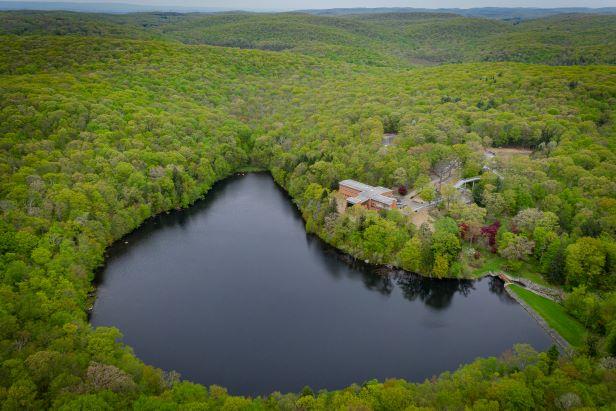Q&A: Kean Expert Advocates Using Nature to Heal and Help

Nature surrounds the Kean Skylands campus, pictured here, in northern New Jersey.
Danielle Servedio, Psy.D, a lecturer at Kean Skylands in Jefferson Township, holds degrees in marriage and family therapy and clinical art therapy. Her work focuses on using art and nature to create optimal healing environments for patient care.
Q. What is environmental psychology, and is it the same as nature and green therapy?
Environmental psychology is the study of the relationship between people and the environment, both built and natural. Our goal is understanding how and why our environment impacts us, how we can use that information to our benefit, and how we can improve our relationship with the world around us.
Nature and green therapy, also known as ecotherapy, aims to improve your mental and physical well-being by spending time in nature. Multiple studies published in the Journal of Environmental Psychology show exposure to nature can have positive health benefits such as reduction in stress and anxiety, and the lessening of depressive symptoms.
Q. How can environmental psychology help with the anxiety caused by the COVID-19 pandemic?
The outbreak is stressful for all of us, but the fear and anxiety around it can cause a severe disruption in normal day-to-day functioning for some adults and children.
A recent study from the University of Michigan states that spending as little as 20 minutes in nature has been proven to reduce stress. Experiencing nature can slow the mind’s natural process of rumination, which is when we worry about the past and future, which can have negative consequences on mental health.
Q. Tell us about Kean’s virtual Earth Week event, Environmental Psychology: Psychological Well-being During COVID-19, co-hosted by Kean Skylands.
It went very well. Members of the Kean community and general public — 82 in all — came together via Google Meet to hear researchers from psychology, conservation biology and environmental geography discuss current findings in environmental psychology. After the lecture, we ran through a Q&A session, mindfulness meditation and yoga practice.
To view the session, click here. (https://drive.google.com/file/d/1ZACulKO2qL8nTRu5d2aKDW_AdfgV1IWG/view)
Besides giving participants a deeper understanding of our relationship with the environment, we also wanted to spread the word about our brand new Kean Skylands campus and the great work we are doing, using the beautiful natural setting of the campus. We partnered with the Earth Science Club and School of Environmental and Sustainability Sciences (SESS) to make this event happen.
Q. What are some specific ways people can use the healing power of nature during this COVID-19 outbreak?
With the recent stay-at-home orders, it is important to look for nature close to home, whether in your backyard or on your balcony, on a walk or bike ride around your neighborhood (maintaining appropriate social distance), or even by simply opening a window.
Activities like starting a small garden, bringing potted plants into your home, sitting in the grass, listening to the sounds of nature, even just looking at a single item from nature like a flower can be beneficial. Certain houseplants, like English ivy, flamingo lily, spider plant, ficus and more, can even help remove toxins from the air and help you breathe easier, an added benefit.
If you can’t get outside, simply looking out the window at a natural view has been shown to be beneficial. If you don’t have access to natural views, several studies have shown that viewing photos of nature and landscapes are also effective in reducing stress. Several national parks are now offering virtual tours online for those unable to get outside.
(https://artsandculture.withgoogle.com/en-us/national-parks-service)
The key is to bring a level of attention and mindfulness to the activity.
Q. Can nature be brought into hospitals or nursing homes to help people in those settings?
Yes! Optimizing a patient’s healing environment is something I am very passionate about.
Plants are a great way to bring nature into places like nursing homes and hospitals as long as they are permitted in that particular unit. The addition of gardening spaces, particularly in nursing homes, would give residents time outdoors and exercise, and let them continue an activity they enjoyed at home.
Incorporating green spaces in waiting areas and community rooms is another way to bring green spaces inside to benefit patients and their family members. Ideally, all care facilities would place nature photography in patients rooms so they could experience the benefits of nature without having to go outdoors.
Lastly, green spaces in a medical setting are not just beneficial to patients but to caregivers and medical professionals as well.